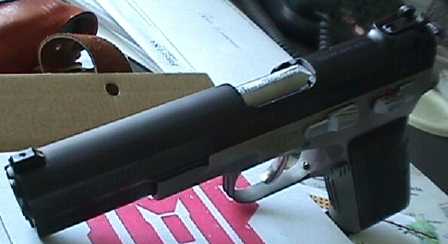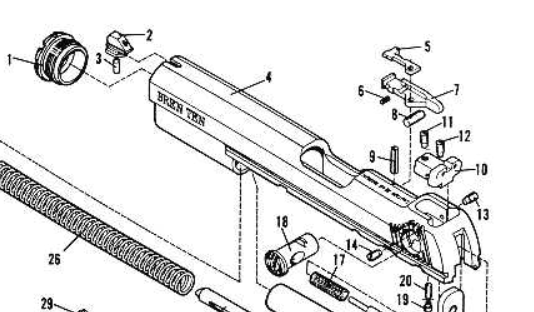¶ Bren Ten Production Variations
There are differences to Bren Ten pistols during their production run. The list below are some of the known variations that occured during the Bren Ten production run. This list will attempt to concentrate on actual production variations and not options that could be purchased or modifications that users had performed on Bren Tens outside the factory.
¶ Trigger Stop
Bren Ten's typically have a set-screw style trigger stop installed in the trigger guard, just before it meets the frontstrap, however locations may vary. Some are ground down (left example) and some are installed in a way where they were not needed to be ground down (right example)

¶ Round Top Slide
Some Brens are missing the front flat-top piece of the slide. See example drawing for comparison.


¶ Safety Dots (2 v 3 Dots)
References to "two-dot" versus "three-dot" Brens pertains to the markings in front of the manual safety on the frame. A "two-dot" Bren has two 1/8" dimples drilled into the frame on both sides of the gun. A small ball bearing on the back of the manual safety rides between the two detents giving the safety a positive "on" and "off" position. Additionally, the upper "on" position detent is painted red so that when the safety is in the down/fire position it is visible to the operator. When the safety is in the up/safe position this red detent is concealed signifying that the pistol is on safe. A "three-dot" Bren though has another dimple drilled in the frame. If you were to draw a ray starting at the center axle of the safety and projecting through the top dot the third dot is about another 1/8" out (measured center to center). On these guns it is this third dot that is painted red. I think it is safe to say that the "two-dot" version is the original form of the safety markings as this is the way the guns are pictured in both the catalog and owner's manual. As to the reason for the third dot I am still not sure. I had originally thought that the third dot was drilled and painted because it is easier to see. One rumor I have heard though, was that the third dot was actually a mistake with some frames being drilled incorrectly. Personally I have no preference of one version over the other. Even if the "three-dot" was a mistake it looks like it should be there.

¶ Rear Sight
¶ New Sight
The allen-head system was replaced with a more common single slot-head screw setup similar to that found on Smith & Wesson and Ruger revolver sights.

¶ Old Sight
The original design of the adjustble sights included the use of two oposing allen-head screws for windage and two on top for elevation.
